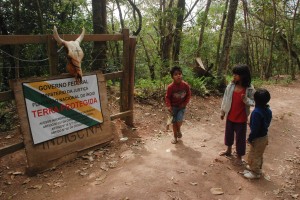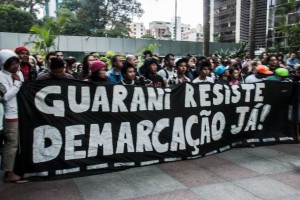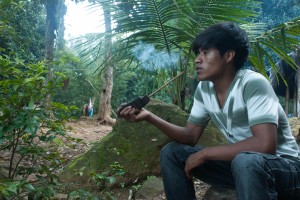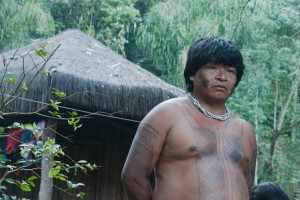 According to the western calendar of the southern hemisphere, spring starts in September. For the Guaraní people, the old year—time for introspection and rest for the earth—stays behind and opens the new year, the time to raise crops, a time of happiness and spiritual uplift.
According to the western calendar of the southern hemisphere, spring starts in September. For the Guaraní people, the old year—time for introspection and rest for the earth—stays behind and opens the new year, the time to raise crops, a time of happiness and spiritual uplift.
“We understand the passage of time not through the four seasons of the year, but as two periods–the new time (Arapyaú) and the old one (‘Araymã),” explains Mbya Sonia Barbosa, an indigenous Guaraní woman, to the Americas Program.
In the new time, the Guaraní celebrate baptism ceremonies for children. The men lead the ceremonies, held in prayer houses made of clay. The women play the taquapu, a rhythm instrument and the men play the embará, a string instrument. The baptism takes place at the amba, a type of altar. “The grandfather enters into a trance and the name of the child is revealed to him,” says Barbosa.
Barbosa lives in one of the three towns that make up the Jaragua indigenous territory, located on the outskirts of the biggest city in South America, São Paulo. There is practically no space for growing crops. They live hemmed into one of the smallest extensions that have been recognized and demarcated by the Brazilian government as an indigenous territory, within an area 1.7 hectares. There is no longer enough corn and yerba mate even for the rituals. “We buy it in the market or get it from our family members that live in the bigger territories in the coastal regions,” explains Barbosa.
The lands inhabited by around 700 Guaraní, many of whom do not speak Portuguese, has three borders. The first is a freeway, ironically named “the banderaintes”, the term used for the men that took the lands and hunted indigenous people like animals to sell as slaves during colonial times. Their territory is also bounded by the Anhanguera and the Rodoanel highways, which connect the capital of São Paulo with the economic hub in the interior of the state. A tourist highway named after the Jaragua indigenous group was built in the middle of the community, dividing it in half.
 The families there live in precarious conditions, with insufficient healthcare, water, and food.
The families there live in precarious conditions, with insufficient healthcare, water, and food.
“Many people that pass through town believe that it is a marginalized neighborhood or a favela. The thing here is that we have many limitations to being able to live our culture fully, because nature creates indigenous culture, and we don’t have land. We are prohibited, for example, from gathering wood in the Jaragua State Park to build our houses. We don’t have a way to collect firewood for cooking, so we find ourselves forced to cook on stoves like the white people. We have to adapt our customs and habits, our way of being in order to survive,” says David Martim, one of the youngest leaders of the town of Tekoa Pyau.
But what for many might seem like another area with inadequate housing inside the city, is really a territory of resistance, protecting the ancestral tradition of the indigenous Guaraní people. “We keep within ourselves our way of being, our Guaraní spirit, our language, our prayers, our rituals. This spirituality is what strengthens us. It’s part of our resistance. Without that strength we wouldn’t be able to continue walking, because we suffer attacks, illnesses, deforestation, disputes over the land,” shares Martim.
Aside from the three Jaragua towns—Tekoa Ytu, Tekoa Pyau, Tekoa Itakupe—is the indigenous land Tenondé Pora, in the southern region of São Paulo, made up of the towns Tekoa Tenondé Pora, Tekoa Krukutu, Tekoa Eucaliptal and Tekoa Guyrapaju. It is estimated that 2,000 Guaraní live in this area. The Guaraní in Brazil are divided into subgroups known as the Mbya, Ñandeva or Xiripá and Kaiová.
The common conception that the indigenous population lives only in remote rural areas does not correspond to reality. According to a report from the Pro-Indigenous commission, with data from the United Nations, some countries such as Australia, Canada, the United States, and Chile have the largest concentration of indigenous populations living in urban zones.
In Brazil, according to the most recent 2010 census data, the indigenous population reached 817,900 individuals. From this total, 36.2% live in urban zones and 63.8% in rural zones. In the state of São Paulo, the data from the 2010 census registered an indigenous population of 37,915 living in cities, which represents 91% of the state’s indigenous population. In the city of São Paulo alone there is a population of 12,977 indigenous individuals and 11,918 of them live in urban zones.
 Guaraní territory consumed by the city
Guaraní territory consumed by the city
While watching the sun set behind the buildings, Ari Augusto Martin lets out a sigh along with his words, “Here everything was mountains.” He is one of the spiritual leaders and guardians of the land. While he talked to the Americas Program, one could hear the sound of the cars speeding by on the freeways that encircle the town.
Urbanization is a process that also involves indigenous peoples. In the forest of the Jaragua, there was no urban presence, they were all rural zones. “The animals and the people moved freely. The Guaraní always believed that fencing off their land was not dignified for them. They always sought out freedom and with that freedom they used the forest, the space. The towns in the south of the city were also free areas for the indigenous people, where they had a contiguous relationship with the coastal people. There were many paths that connected the towns of the city of São Paulo with the towns of the southern coast of the state. This access was continuous, there was no division or limits for gathering, for hunting,” affirms in the researcher Maríe Inés Ladeira.
The University of São Paulo geographer and researcher, Camila Salles de Farias, explains that the indigenous towns of Jaragua have been resisting absorption by the expanding metropolis through reproducing their traditions and way of life as a community. “With the installation of big industry and the forming of the district of Jaragua, a bus system was developed and implemented, which gave way for the expansion of production in the urban space, but it was still predominantly rural. Then in the following decades, the banderaintes freeway was build, and thus there was a growth in the production of irregular settlements that replaced the rural zones,” affirms Salles.
Ladeira agrees that the expansion of the city has swallowed up indigenous towns. “When it is said that the land of the Guaraní is very close to the cities, the truth is that is city consumed the Guaraní territory.”
If in the countryside the pressure exerted on indigenous communities has been from agroindustry and huge infrastructure projects, in the urban context the reproduction of capital has been through the expansion of large structures that have corralled indigenous people into small parcels of land, subject to forced displacement.
“Capitalist production has its most important speculation center in the city of São Paulo, and thus, in terms of the valorization of space, there exists an impossibility in terms of urban land use for the majority of the population, which leads to a continuous process of displacement of non-indigenous people into the places that are further or closer to the periphery, in this case, toward indigenous lands, thus aggravating and intensifying the conflict over the struggle for space, since the spaces of indigenous communities are seen as being threatened, above all if they are not regularized,” says Salles.
São Paulo is itself an expression of modernity as one of the principal metropolitan areas in the world, and has its intrinsic contradictions. “What is seen as a tendency for the suburbs to be pushed further and further and for the city centers to expand are the new entities of modernity,” explains Salles.
There is a tendency to expropriate land from indigenous people, according to the researcher, and Jaragua is a flagrant example of this process. “Today expropriation comes from the growth process of the city, of the process of moving things toward the periphery, that continually pushes poor people to the outskirts, since living in the city has becomes more expensive, and poor people occupy areas that the indigenous people have historically used. This is the logic of production in the city of São Paulo,” says the geographer.
“The logic of the indigenous Guaraní of living on the land is based on its usage, and not on the logic of private property. They resist and fight so that recognition of their territorial rights are guaranteed by the State, which is essential for their survival,” says Salles.
Stagnant demarcation
The National Indigenous Foundation (Funai) concluded an anthropological study that demonstrated that the lands of the Jaragua, just like the Tenondé Pora, continue to be used traditionally by the Guaraní. However, the revision process for demarcation has come to a standstill in the Ministry of Justice.
The Jaragua indigenous lands were demarcated in 1980 in an agreement with the state government. They demarcated small plots of land, leaving aside minimal criteria for the physical and cultural needs of the people. With the 1988 Constitution, these criteria changed, theoretically establishing the minimum conditions required for indigenous people.
Before this constitution, demarcation only took into consideration living space for indigenous individuals, without including space for gathering, hunting fishing and farming. The idea was to demarcate small plots of land because the State’s goal was to integrate of indigenous people into Brazilian society.
Shortly after the approval of the constitution, the Guaraní continued to demand the adjustment of their lands, in such a way that that recognition would be considered their territory as such, including the diverse ways they had always used the land. After making many demands, the study was undertaken for the first time in the year 2000, but it stopped and re-started and in 2009 was finally completed. In Jaragua, in April of 2013, the Funai recognized the need to correct the borders of the territory and considered 532 hectares of land to be traditionally occupied by the Guaraní, including the three actual towns, the places where people had lived in the past, and the key areas for their physical and cultural needs, including that which had been named a protected area, the Jaragua State Park.
“The Guaraní have an unbreakable relationship with this land. The mothers buried and continue to bury the placenta of their children in the earth. This means that the child’s soul unites forever with the land. It is an area that they are not willing to give up under any circumstances,” says the anthropologist from the Center for Indigenous Employment (CTI), Daniel Calazans Pierri, to the Americas Program.
The threat of displacement
Since 2002, the Guaraní have disputed in the courts the possession of the area of the zone abutting the town of Pyau, which is where the majority of the residents of the Jaragua indigenous territory live. Two alleged landowners demand the recuperation of these lands from the indigenous people, alleging that they have property titles in the zone. These individuals do not live there and have never lived in the place that the Guaraní consider their traditional usage. Although the Funai has recognized the zone as part of the Jaragua indigenous territory, the process is at a standstill in the Brazilian justice system.
Since 2005, the Jaragua Guaraní have also filed complaints before the courts regarding the area of the town of Tekoa Itakupe (Rising Sun). The indigenous people there, who consider the area as part of their traditional lands, were driven out in 2005, through a court action. Funai appealed the decision and concluded the studies that recognize the zone as part of the Jaragua indigenous lands. An expert in anthropology, designated by the courts, also confirmed that the Guaraní have traditionally used the area.
Tired of waiting for the demarcation process to end in the Jaragua indigenous territory, the Guaraní retook the land of the town Itakupe in June of this year, in order to avoid having the land occupied and divided into lots illegally. They worry that in any given moment their town might be taken from them.
According to Article 231 of the federal constitution, all administrative acts related to the possession of traditional indigenous lands are considered null and void. Thus, if the federal government opens up the demarcation of the land, the supposed titles of individuals in dispute with the Guaraní would become invalid.
What does the Ministry of Justice say?
The Ministry of Justice confirmed to the Americas Program, through its Media Relations department, that the administrative process of the Jaragua indigenous lands is now back in the hands of Funai, through a decision made by the Ministry’s Legal Consultancy to move ahead with the proceedings. “Only after the legal analysis of the responses to the questions put forth by the Legal Consultancy did the procedure have continuity.” However, when asked about what these proceedings would be, the department gave no response.
In relation to the administrative process of the indigenous lands of Tenondé Porã, “It is in the hands of the Ministry, since it is necessary to mediate questions relating to public state and municipal goods and located within indigenous territories, with the goal of making the continuity of the administrative procedures viable,” says the Ministry of Justice’s Media Relations Department.
For Martim, the Ministry seeks to establish a “game of hot potato, throwing it from one side to the other,” to avoid responsibility, especially in the current elections context. Elections will take place in October, but until now none of the presidential candidates in Brazil have spoken about the topic of indigenous people, and have not mentioned the possibility of resuming the demarcation of indigenous land.




